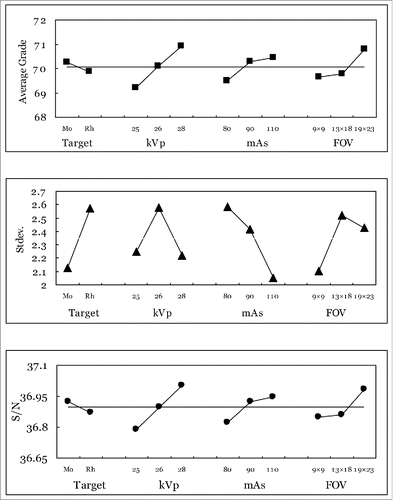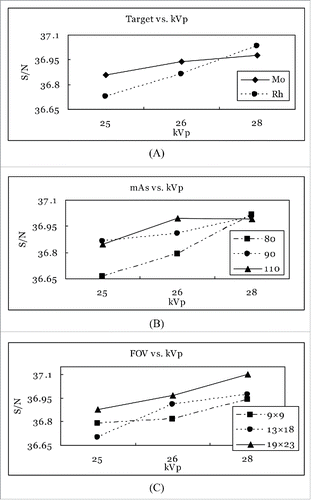Figures & data
Figure 1. (A) The American College of Radiology (ACR) accreditation mammographic phantom, model 156, had an acrylic (PMMA) block that contained replaceable wax, which approximated a 4.0–4.5 cm-thick compressed breast. The wax contained target structures, comprising (1) 6 fibrils; (2) 5 groups of micro-calcifications and (3) 5 nodules of decreasing diameters and thicknesses, all arranged in a 4×4 matrix. (B) the optimal X-ray image of the phantom.

Table 1. the corresponding 18 groups of orthogonal arrays for optimizing the mammographic phantom image according to the Taguchi. Each factor has 2 or 3 levels to compose the unique combination of X-ray operative setting in this work.
Table 2. Average grade, η (loss function), of the mammographic image and its accompanying AGD for the 18 groups of factor values. The average grade was obtained from 5 well-trained radiologists judged data in this work. The automatic glandular dose (AGD) was copied directly from the X-ray machine reading.
Figure 2. the average grade of the phantom image from the 5 judged radiologists, standard deviation of the averaged grade and the derived S/N (η) versus various operating factors for X-ray mammography. The highest η values in various factors represent the optimized setting of that specific factor in this work.

Figure 3. The cross interaction between factors for various cases. (A) Target vs. kVp, (B) mAs vs. kVp, and (C) FOV vs. kVp. The presence of 2 or 3 lines in the 3 parts reveals weak interactions, indicating that no factors interact with each other in all instances.

Table 3. Comparison between AEC setting and optimal recommendation of X-ray device for mammography. Two conventional settings that are used in most hospitals are also presented for reference. Conventional factor combination II is exactly the same as that which yields the highest S/N value when factors are considered separately [].
Table 4. ANOVA and F-test of factors for X-ray mammographic imaging system. The confidence level was treated as significant if the percentage over 95% and the contribution defines as the ratio of SS of every factor (SSfactor) to their summation (SSTotal).
